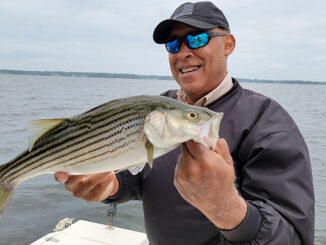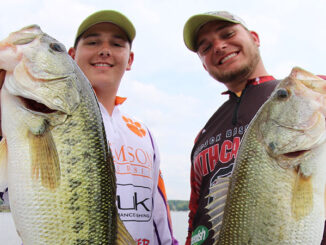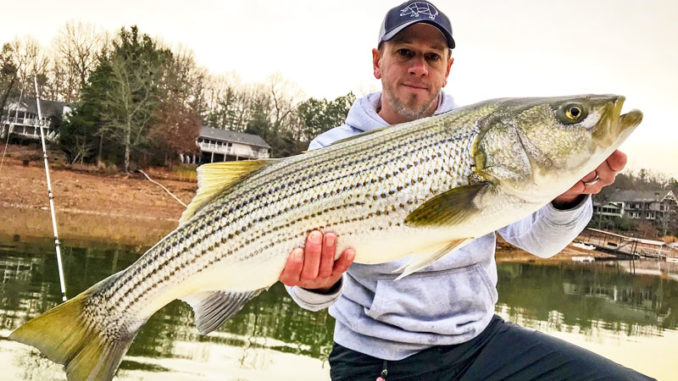
These half-dozen bodies of water in the Carolinas are sure-fire places to get your string stretched by a big striper between April and June.
Outstanding striper fishing is found throughout the Carolinas, but some lakes seem to be more consistently productive at certain times of the year.
With late-April and May being a bit of transition time for stripers that are going through a spawn or “false spawn,” fish are often on the move but typically also feeding heavily.
Be sure you know the regulatory requirements in advance before fishing any striper lake. Management strategies often require diverse size, slot and creel limits, and changes to regulations may also happen during the year on specific lakes or rivers.
Here’s a look at bodies of water in North Carolina and South Carolina that consistently provide anglers ample opportunity to get their strings stretched.
Lake Hartwell
May typically produces sensational striper fishing on South Carolina’s Lake Hartwell for quality and quantity of fish, and anglers can enjoy fast action using live bait and artificial lures.
Live-bait fishing is the early morning “go-to” tactic for many fishermen, according to Preston Harden of Bucktail Guide Service.
“Blueback herring are the preferred bait for most Lake Hartwell striper fishermen,” Harden said. “The key is to always keep fresh bait on the line and to keep adjusting the depth to keep at or just above the depth stripers are marked on the graph.”
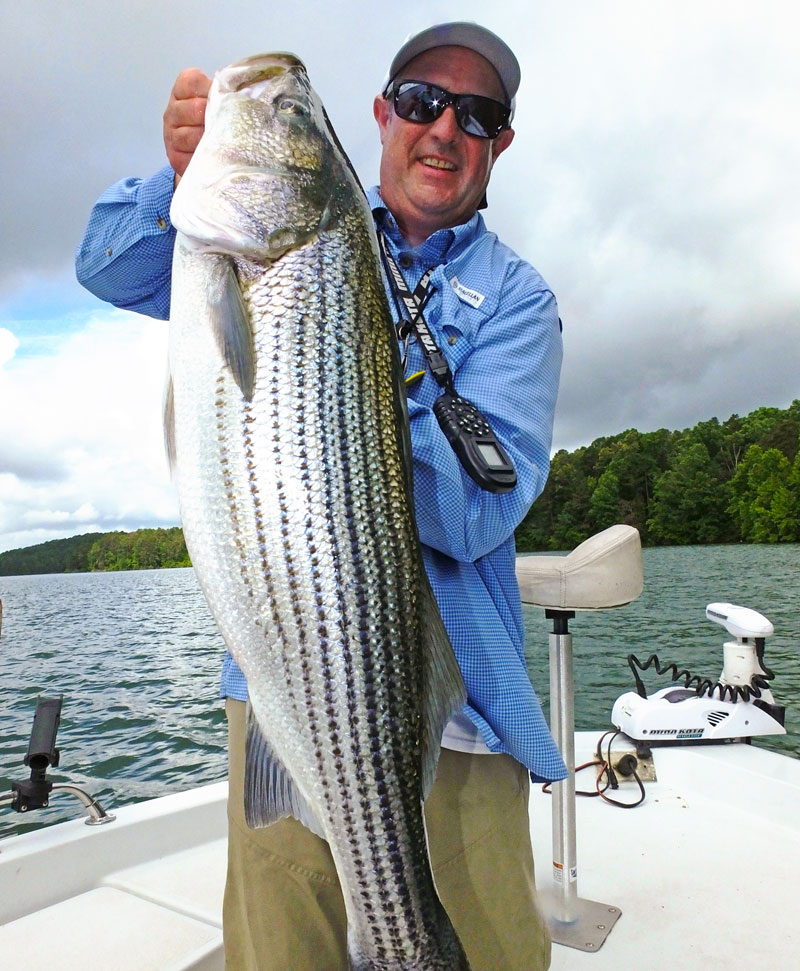
Hardin, who lives on the lake near Townville, S.C., relies on his electronics to find the fish and forage concentrations. Stripers are in large schools, and the specific location will vary daily, but the fish are usually found throughout the 56,000-acre lake by May.
“Some fish will still be up the rivers in late April, and early May,” said Hardin (706-255-5622). “But as the month progresses, the lower half of the lake begins to hold more fish. I fish nearly every day, so I track fish movements closely, and when I get on a big school of fish, they tend to linger in the same general area for a while, making the fish-finding process easier.”
Hardin said prime places to find stripers are mid-lake humps with deep-water access. Also, long points in the larger creeks and coves are among the first places he checks, but humps and points on the main lake can be excellent.
“If I see a reasonable number of fish on the graph that I believe are stripers, I’ll usually drop baits,” he said. “I don’t have to have a screen full of fish to set up. Once we hook a couple of fish, the fighting fish seems to pull every striper in the area to the boat.”
Hardin said that the entire month of May is productive, but if you get a chance to fish on a cloudy day or a day featuring light rain, get your gear and go.
“I love the overcast and misting rain days,” he said. “The action is better for longer periods of times.”
Working artificial lures is extremely effective, and Hardin is always watching for schooling fish action.
“I only need to see one or two fish blow up on forage to go after them,” he said. “I’ll usually pull a couple of free-lines with live herring out the back of the boat, and we’ll cast in front of the boat using topwater, ‘walk-the-dog’ type lures being a favorite.”
Lake Hiwassee
Although the North Carolina state-record striped bass, weighing 66 pounds, was caught from 6,000-acre Lake Hiwassee in 2012, odds are good the fish didn’t spend its whole life growing in those waters.
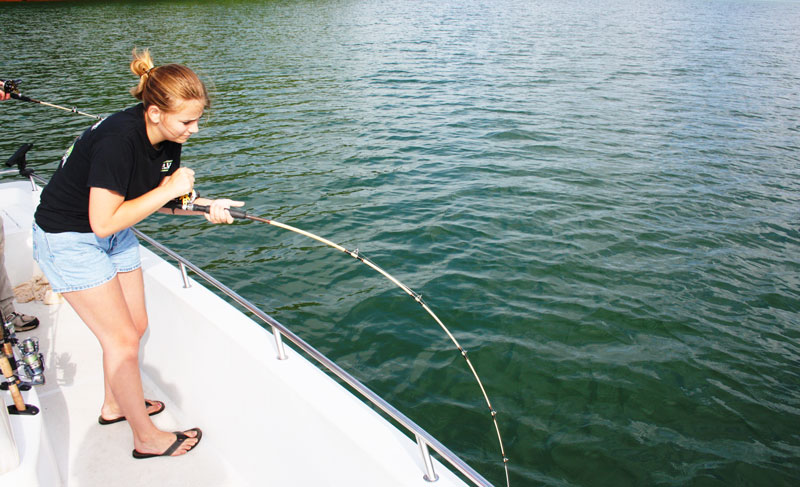
Shane Goebel with Big Ol’ Fish Guide Service said that the record fish may herald future fishing trends, because Hiwassee Lake’s striper fishing is booming, as recent stockings in the lake has developed a very strong class of fish.
“Many believe the state-record fish likely originated from (Georgia’s) Lake Nottely and was likely carried into Hiwassee during a high-water event,” he said. “I also think it’s a harbinger of things to come, because last year, we caught several fish over 30 pounds from Lake Hiwassee, and the lake is teeming with stripers in the 10- to 15-pound class.”
Goebel (828-361-2021) said the fishing patterns for mid-April through May and into June are fairly predictable, with most stripers moving up the rivers and numerous large creeks.
“They’re looking for some moving water, and they’ll go upstream, and that’s where we’ll fish until early May,” he said. “The Hiwassee River will hold fish, but also places like Chambers Cove, Beaver Dam Creek and similar areas have fish in good numbers. The lake is loaded with fingers off the main lake that will hold stripers in April to early May.
“We fish these areas with live bait and prefer blueback herring and gizzard shad,” he said. “We’ll slow-troll with electric motors and pull free-lines and planer boards in the back of the creeks to start the day. As the sun gets up, we’ll typically move out a little deeper using the same technique.”
Goebel said the deeper he gets into May, he’ll gradually transition with the fish as they move back to the main-lake area, focusing on mouths of creeks, points and humps. As water continues to warm, the fish will begin to school up.
“I’ll use electronics to find stripers and forage, and by late May and June, we’ll be setting up on the schools and fishing vertical with live bait,” he said. “As the strong year-classes of stocked fish continue to grow, along with other stripers that have flooded into the lake, I think in 10 years, we’re going to have some real monster stripers in this lake.”
Lake Murray
Striper fishing patterns on South Carolina’s Lake Murray are quite diverse during May, with both artificial lures and live bait producing excellent results.
Guide Brad Taylor of Batesburg, S.C., said his philosophy is that stripers are typically on shallow points, humps and flats early in the morning, feeding aggressively. They can be taken with various artificial lures including “walk- the-dog” type topwater lures, as well as Flukes and bucktails.
“This is exciting fishing, because we’ll often find the fish in fairly shallow water in low-light conditions,” said Taylor (803-331-1354), “but when they scatter, we’ll search the deeper areas and find them in schools suspended over deeper water.”
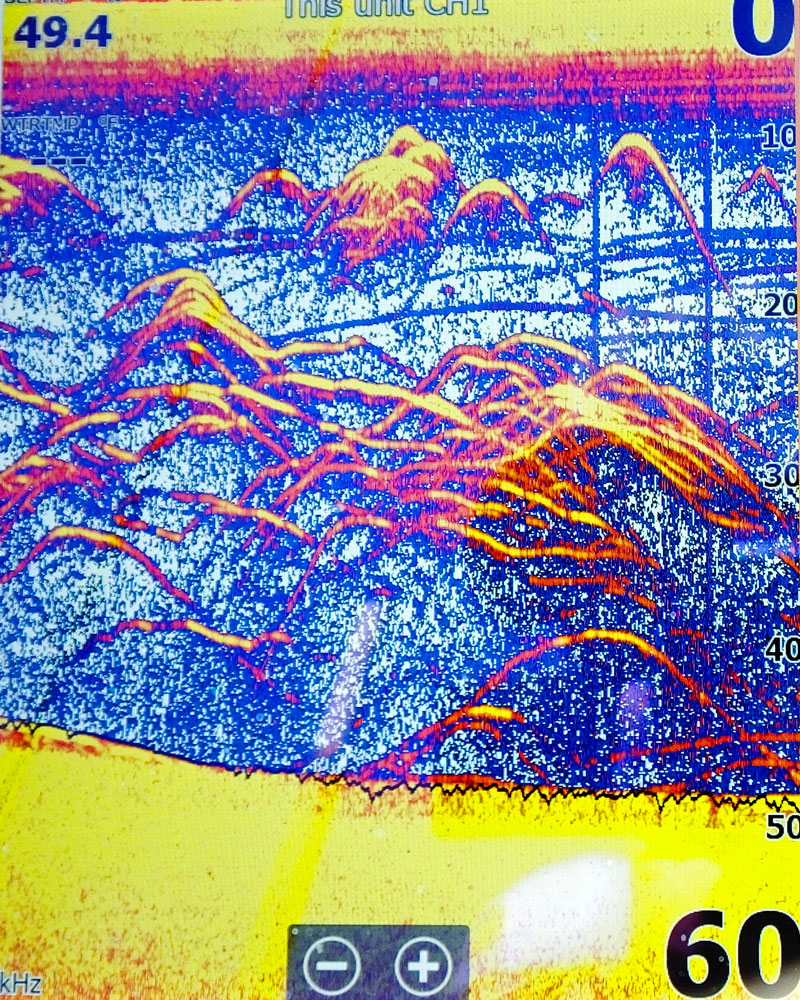
Taylor targets underwater topography changes as striper holding areas and employs his graph to check points, humps, ledges and deep holes.
His live bait of choice is blueback herring, and he rigs multiple rods to present the bait in different ways. He’ll work live bait on down rods for deep, suspended fish and position baits at or just above the targets on the graph. He’ll pull free-lines with no weight well behind the boat to target fish higher in the water column. Planer boards are used to pull rigs away from the boat at a pre-determined depth and over the ledges where shallower flats drop into deep water.
Roanoke River
Weldon, N.C., is known as the “Rockfish Capital of the World”, the striper fishing on the nearby Roanoke River in northeastern North Carolina certainly fully lives up to this moniker.
“The fishing on the Roanoke River, in the part I fish near Weldon, is crazy good during the last half of April and first half of May,” said guide Greg Griffin. “The fish move up the river on a spawning run from the Albemarle Sound; that actually begins in March. But they reach the waters below the Roanoke Rapids Lake by mid-April in huge numbers.”
Griffin (919-434-4183) said that off-the-chart type fishing doesn’t last long, but while the run is on, it’s sensational. The keeper season ends April 30.
Griffin, from Holly Springs, N.C., said both anchor-fishing and drifting are effective, but he typically prefers to anchor.
“I like to set up on a huge school of fish and have everyone in the boat hooked up,” he said. “Electronics are the key to my success; I’ll use my graph to locate huge schools of fish and then anchor just above them using my electronic anchoring system on the trolling motor. I usually find them in deeper stretches; sometimes they’ll be stacked 8- to 15-feet thick.”
Griffin uses a basic Carolina rig with a 7-foot, medium-action rod and a reel loaded with 12-pound line. To the terminal end, he ties a 3/0 circle hook; his preferred sinker weight is a ½-ounce, but he will use up to 2 ounces when discharge is high from Roanoke Rapids Lake and the water level rises.
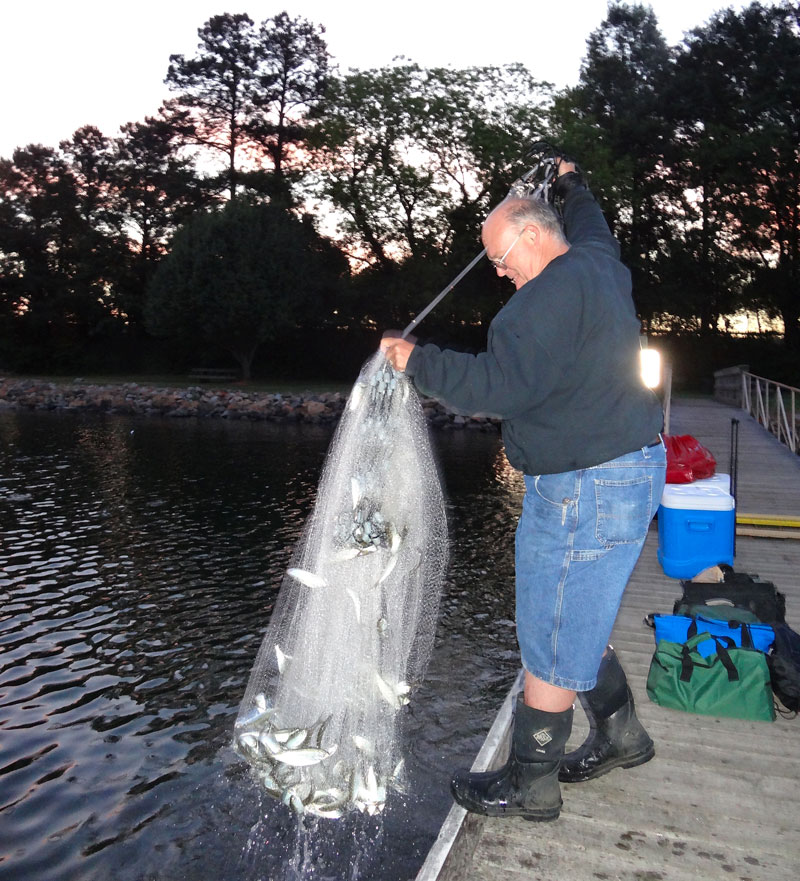
Griffin said various baits will produce, but herring are by far the best.
“Live herring is king; I think will out-produce anything else by 10-to-1,” he said. “But cut herring works well, so I can get multiple baits out of a single herring.”
Clarks Hill Lake
Clarks Hill Lake, which covers 71,100 acres on the Savannah River along the Georgia-South Carolina border, supports an excellent population of stripers and hybrid bass, and the mid-April to early June time period typically produces dependable and fairly predictable patterns.
Guide Allen Icenhour of Trenton, S.C., said May patterns are very dependable.
“Stripers and hybrids will be found in the lower end of the lake, and the patterns are not difficult to determine,” he said. “I rely on down-rod fishing using live bait, usually blueback herring. At this time of the year, the fish will orient to specific targets such as humps, points and drops in the lower end of the lake. The basic depths they prefer are from 20 to 40 feet, with the stripers moving progressively deeper as the water temperature rises.”
Icenhour (803-480-9472) depends on his electronics to find schools of stripers or hybrids. Marking a lot of fish that he believes to be stripers is the best indicator of a place to fish, although in May, it doesn’t take a screen full for him to stop and check an area.
His basic fishing rig is a 7½-foot rod with a light tip, a reel spooled with 20-pound line and a 6-foot fluorocarbon leader. He’ll use a 1- to 2-ounce egg sinker depending on depth fished.
Lake Norman
Lake Norman is a big lake (32,500 acres) with lots of places for stripers and hybrids to hide, but Craig Price of Fish On Guide Service said the May to June time frame produces lots of action, and it’s a time when striper patterns are fairly predictable.
“The water temperature controls the exact timing of what I call the false spawn,” he said. “But from mid-April into May, we usually have fish far upriver in the old Catawba River channel. The action usually begins in March, but as fish finish the spawning effort, they begin migrating back down the lake.”
Price (704-996-0946) said the river fishing is usually live-bait fishing with herring and threadfin shad being top choices.
“We’ll have current, and I’ll fish a variety of baits and rigs to cover all depths for the water column,” he said. “I’ll fish from a fixed position, using either spot lock or tying to a shoreline tree and use free-lines, lines rigged with a 1/8- or ¼-ounce weight and cut bait fished on the bottom.”
Typically, Price will find a pattern for the day and work that pattern. As the season progresses, many stripers begin to migrate back down the lake, and he adjusts his targets accordingly.
“By mid-May, I’m typically fishing the mid-lake area and working long, sloping points and deep banks,” he said. “Live bait continues to be productive, but I’ll also fish artificial lures, with the Alabama Rig being very productive at times.”
The transition continues from May into June, and Price said stripers continue moving further down the lake and spreading out. He targets the creek mouths where they meet the old river channel. He said the deeper points and ledges are also productive.
“The action stays good throughout this transition, but the key is staying on top of the striper movement as they migrate from the upper end back down the lake,” he said. “I use electronics and time on the water to help me stay in touch with the fish.”
Lake Hickory: A sleeper for big stripers
Guide Craig Price said one of his favorite places to catch big, spring stripers is on Lake Hickory, a 6,200-acre reservoir two impoundments upstream from Lake Norman on the Catawba River chain in North Carolina’s Foothills.
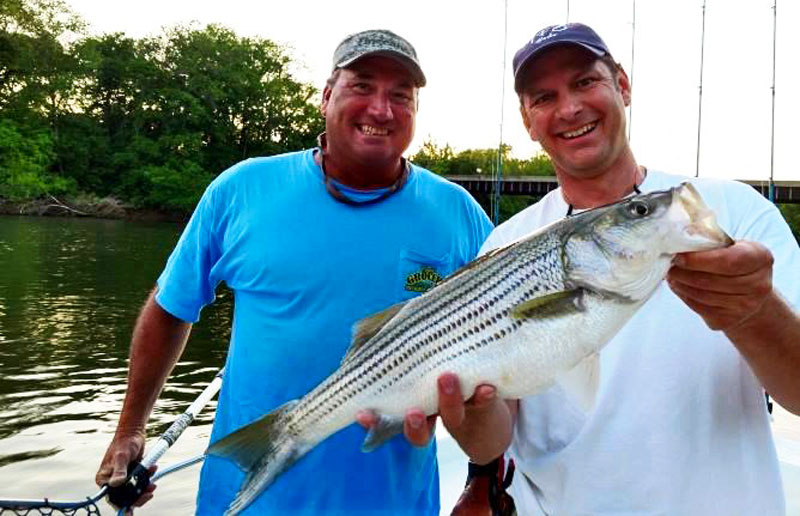
“Many of the fishing patterns are the same as Lake Norman for this time period,” he said, “but when stripers begin to migrate down this lake, one major difference is Lake Hickory doesn’t have the long, sloping points characteristic of Lake Norman.”
Price said another key on Lake Hickory can dramatically change patterns.
“As the water warms through May and into June, I’ve learned that when water is released into the upper end of Hickory the water is cooler and highly oxygenated,” he said. “That, plus the current flow, draws fish from downlake toward the upper end.
“Good-sized stripers are caught at a lot of lakes, but in this part of the state, if I’m trying to catch a striper in the 15- to 25-pound class, I’d pick Lake Hickory.”

